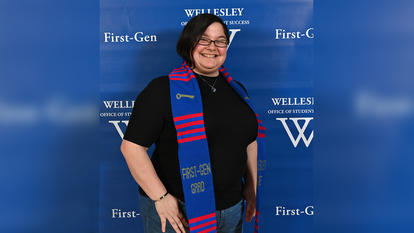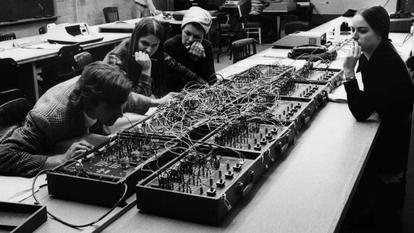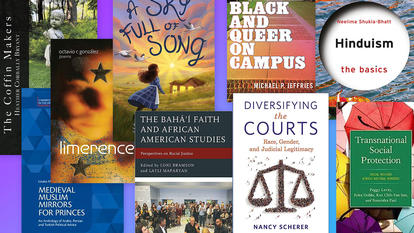Spotlight on Teaching: Two Art History Classes Collaborate on an Innovative Website

Art history students of Kimberly Cassibry and Liza Oliver, both assistant professors of art at Wellesley, have collaborated on a website that provides detailed information about the monuments featured in the exhibition Reframing the Past: Piranesi’s Vedute di Roma, which opened in February and runs through July 9 at the College’s Davis Museum.
“We don’t typically assign group projects like this in art history,” said Cassibry. “Piranesi’s etchings of ancient Roman sites offered an ideal pivot point.”
Work on the project began last fall, when Cassibry’s students in Roman Monuments: Memory and Metamorphosis built the website, which is accessible from the exhibition’s homepage, and created an audio guide to the ancient structures that appear in Piranesi’s etchings. This semester, Oliver’s students in Art and Architecture of the European Enlightenment are expanding the website, adding information and context about the etchings produced between 1747 and Piranesi’s death in 1778.
“One of the best ways to learn a topic is to teach it. I wanted my students to experience that kind of learning,” said Cassibry, who curated the Piranesi exhibition with Meredith Fluke, Kemper Curator of Academic Programs, and participation from Oliver. “I also liked the idea of producing a scholarly work that would outlive the seminar. The website gave us a shared goal, a broader audience, and a product that we can all continue to use.”
Before they began work on the site, Cassibry’s students read the classic 1903 essay “The Modern Cult of Monuments” by Alois Riegl, who helped establish art history as an academic discipline. In it, Riegl outlines various issues art historians should consider regarding a preservation project. Students also read “The Neuroscience of Memory,” by neuroscientists Ann-Kathrin Stock, Hannah Gajsar, and Onur Güntürkün, about how the human mind filters sensory input.
The students worked in teams to design hypothetical monuments about current events and then imagine how those monuments might look and function several hundred years from now. Those assignments were fun, Cassibry said, but also helped the class think creatively about concepts they would use to explain monuments on the website.
Work on the site began with students examining images and maps from the 17th to 19th centuries in Wellesley’s Special Collections and the Davis Museum’s print study room; analyzing the monuments featured in Piranesi’s sketches; and collaboratively writing entries about them for the museum’s visitors. The group quickly realized that they had to conduct the same kind of research they would for an academic paper, yet communicate their findings in a more accessible way. They also had use consistent formatting for citations and entries.
“Designing this website challenged us to convey our knowledge of ancient Roman monuments and the history of their survival to the general public in a clear and effective way,” said Hannah Augst ’17, an art history major who chose the course because of its unique hands-on approach.
“Given that we were limited to about 300 words per section, I had to really think about how I was going to convey my ideas without being too verbose,” said Sheree Liu ’17, a double major in computer science and art history. “At the same time, I also adjusted my writing for a larger, more general audience, which sometimes required more explanation for obscurer art terms and topics.”
During the second phase of the project, Cassibry’s students created an audio guide about the etchings for the museum’s new Cuseum app. Each student was assigned a specific image and had to make an appointment with Bo Mompho, registrar of the Davis Museum, to view it before it was framed for the exhibit.
“These appointments are how professional art historians conduct a large part of their research, and I wanted students to leave the seminar knowing how to do that,” Cassibry said. “During their appointments, the students analyzed the images visually and looked at the related ‘object file,’ which typically has information about acquisition and conservation work and copies of any relevant publications.”
Each student then wrote and recorded an introduction that offered an insider’s view of what to look for in the etching and how to understand the buildings Piranesi depicted. The website and audio guide were ready when the exhibition opened on February 10.
Oliver’s class is now working on the project. Students in her Art and Architecture of Europe’s Enlightenment course will write about monuments in Rome as they were understood by 18th-century audiences, particularly by British aristocrats making the “grand tour” of Europe. The students’ essays will cover topics such as urban life in 18th-century Rome, the discovery of Pompeii and Herculaneum, and the relationship between antiquity collecting and early tourism as a form of consumerism.
Liu, who is taking Oliver’s class, is eager to see how the website develops. “Studying art is not just about the works themselves but also the contexts they are created in, be it historical, political, theological, socioeconomical, or anything else. I found that to be especially true for this project,” she said.
Oliver concurs, and said she hopes her students will gain a deeper understanding of the role of art historians. “Research and writing in the humanities are often solitary, and students usually don’t imagine the audience for their work extending beyond their professor. This project requires that they translate their knowledge of art history for a broad audience, which changes how they think about and engage with the material,” said Oliver. “It also allows them to think creatively about collaborations between digital and actual platforms for displaying works of art.”
Support from Wellesley’s Mellon-funded Blended Learning Initiative helped make these courses possible. Ruth Rogers, curator of Special Collections; Meredith Fluke, Kemper Curator of Academic Programs at the Davis Museum; David O’Steen, associate director of the Mellon Blended Learning Initiative; and Jenifer Bartle, manager of Wellesley’s Digital Scholarship Initiative, were also helpful in developing this project.



